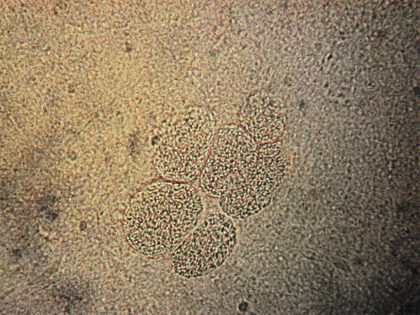Toxoplasma gondii: one species with several genotypes; but do these induce differences in the host’s immune response?
The latest Paper of the Month for Parasitology is “Early immune responses and parasite tissue distribution in mice experimentally infected with oocysts of either archetypal or non-archetypal genotypes of Toxoplasma gondii“
Toxoplasmosis is a well-known disease caused by the single celled parasite called Toxoplasma gondii, which is found worldwide. The infective form of the microorganism is spread in the environment by the faeces of domestic and wild cats. It is also transmitted in the meat of infected hosts or from mother to offspring, during pregnancy. The intermediate hosts, in this complex life cycle, can be any bird or mammal, including humans. The symptoms caused by T. gondii infection are mainly reproductive, but toxoplasmosis may encompass fever, fatigue and in an individual born with the parasite it can result in malformation and ocular problems.
Genetic differences of T. gondii exist; relatively few genotypes occur in Europe and North America while hundreds of different strains exist in Asia, Africa and South America. But are these mutations “nasty” and responsible for difference in virulence, host immune response and symptoms? The immune response is seriously complex, which makes it essential to choose a good study model. We chose Swiss Webster mice, divided them into three groups that received three different strains of T. gondii to drink. The oral route of infection is very common in small rodents, usually from contaminated water or feed.
Once the animals were infected, we needed to select our immune targets to follow the interactions of the host with the parasite. And, people, there are many targets! Dozens of groups of defense cells along with the myriad of substances they produce to help the host to fight infections. We decided to look into the initial immune responses, happening within the first few hours and days of the infection, because these early responses will affect subsequent responses. We targeted groups of lymphocytes and cytokines (one kind of the defense cells and products that stimulate the immune system) from the mesenteric lymph nodes and spleen, organs that are responsible for the first counterattack. To follow the progress of parasite infection within the host, we looked for its DNA in seven different organs that the parasite aims.

As for results, yes, we found different immune responses between groups! For one strain, from South America, which causes severe disease, we observed generalized infection with a huge and fast production of substances that increase the immune response to a dangerous level, without self-regulation. The second strain, also from South America, causes milder symptoms and mice can survive its infection. We verified that in this group the parasite had established into many organs, but the immune response was balanced, occurring slightly later and controlling the infection. A third strain was tested, a common genotype from Europe, which did not affect the mice. The parasite was controlled effectively probably due to fast responses by the host’s phagocyte cells. Although many other immune responses to the parasite could be involved, we hope that the discoveries reported here may help us to understand how toxoplasmosis develops and how it can be treated in the future.
The paper “Early immune responses and parasite tissue distribution in mice experimentally infected with oocysts of either archetypal or non-archetypal genotypes of Toxoplasma gondii“, by Daniela P. Chiebao, Paul M. Bartley, Francesca Chianini, Lauren E. Black, Alison Burrells, Hilda F. J. Pena, Rodrigo M. Soares, Elisabeth A. Innes and Frank Katzer, published in Parasitology, is available free for a month.






